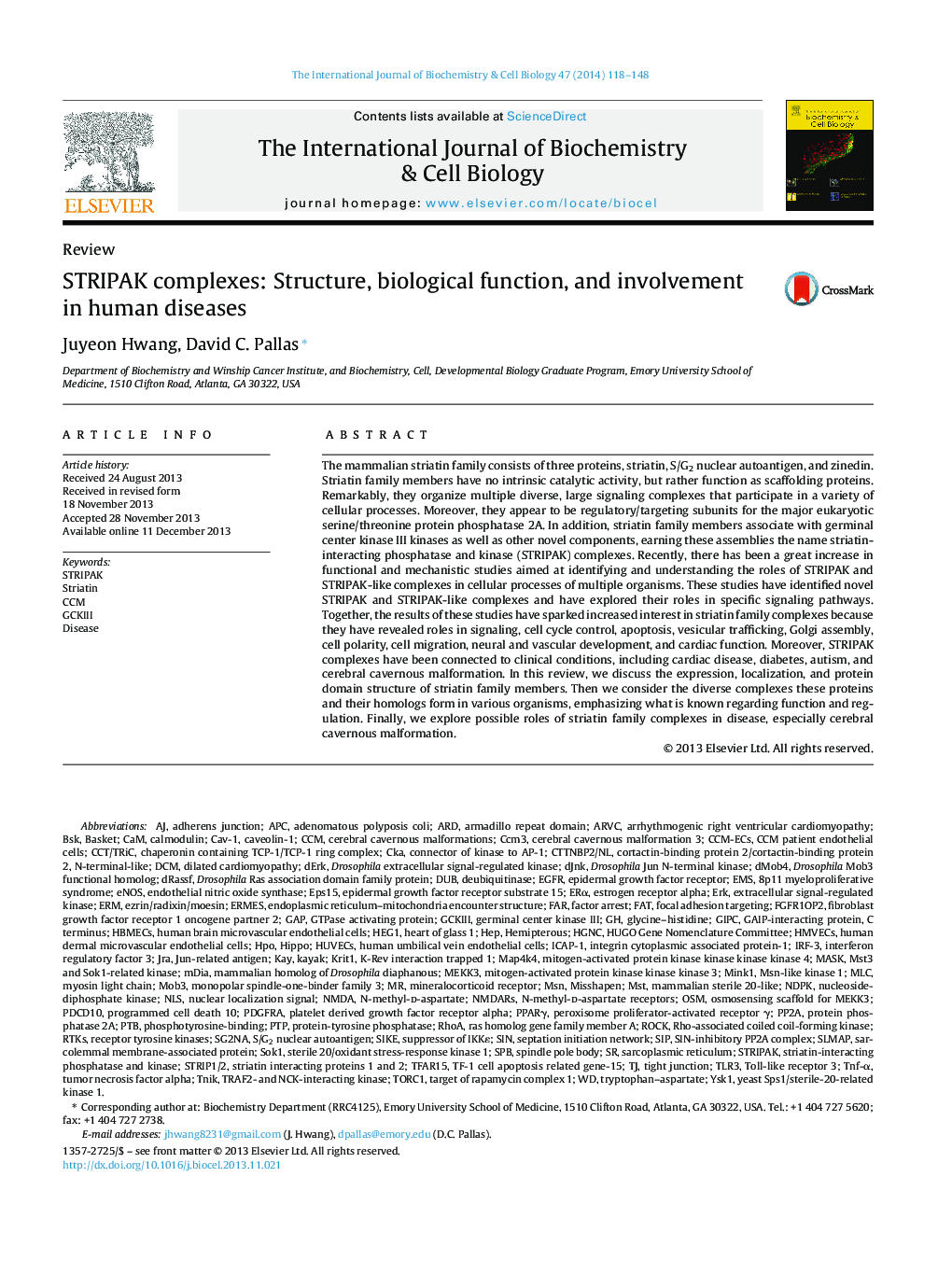| کد مقاله | کد نشریه | سال انتشار | مقاله انگلیسی | نسخه تمام متن |
|---|---|---|---|---|
| 1983582 | 1539897 | 2014 | 31 صفحه PDF | دانلود رایگان |
عنوان انگلیسی مقاله ISI
STRIPAK complexes: Structure, biological function, and involvement in human diseases
ترجمه فارسی عنوان
مجتمع های استرپیک: ساختار، عملکرد بیولوژیکی و دخالت در بیماری های انسانی
دانلود مقاله + سفارش ترجمه
دانلود مقاله ISI انگلیسی
رایگان برای ایرانیان
کلمات کلیدی
EGFRMSTDCMOSMHGNCHUGO Gene Nomenclature CommitteeHUVECSRhoAERKPP2APPARγPTPEMSeNOSAPCERMNMDAN-methyl-d-aspartateMSNERαNMDARsNLSARDSPBPDGFRATLR3SIPHEPPTBEPS15MLCIRF-3KRIT1ARVCNDPKERMESSTRIPAKCCM3DeubiquitinaseDUBMAP4K4septation initiation networkTORC1MEKK3mDiaMisshapenGIPCProgrammed cell death 10PDCD10HBMECsepidermal growth factor receptor substrate 15BSKarmadillo repeat domainHMVECsJRAdJnkCCm - CCMezrin/radixin/moesin - ezrin / رادیسین / moesinGTPase Activating Protein - GTPase فعال کردن پروتئینHpo - HPORTKs - RTK هاadenomatous polyposis coli - آدنوماتوز پولیپوزیس کولی یا آدنوماتوس پولیپوزیس کولای Tight junction - اتصال تنگhippo - اسب آبیStriatin - استریاتینSpindle pole body - بدن قطبشsin - بدونFAR - بعداDisease - بیماریtumor necrosis factor alpha - تومور نکروز عامل آلفاTNIK - دفتر خاطرات روزانهSarcoplasmic reticulum - رتیکولوم سارکوپلاسمیکmyosin light chain - زنجیره سبک میوزینCAM - ساخت به کمک کامپیوترBasket - سبدHuman brain microvascular endothelial cells - سلول های اندوتلیال میکرو عروقی مغز انسانHuman umbilical vein endothelial cells - سلول های اندوتلیالی ورید ناف انسانhuman dermal microvascular endothelial cells - سلولهای اندوتلیال میکرواسکولی پوست انسانendothelial nitric oxide synthase - سنتاز اکسید نیتریک اندوتلیالnuclear localization signal - سیگنال محلی سازی هسته ایGAP - شکافInterferon regulatory factor 3 - عامل تنظیمی اینترفرون 3Ras homolog gene family member A - عضو خانواده خانواده ژن رای همولوگTNF-α - فاکتور نکروز توموری آلفاphosphotyrosine-binding - فسفاتیزین اتصالMask - ماسکCerebral cavernous malformations - ناهنجاری های مغزی مغزیtarget of rapamycin complex 1 - هدف از مجموعه رپامایسین 1focal adhesion targeting - هدف قرار دادن چسبندگی کانونیhemipterous - همرنگProtein-tyrosine phosphatase - پروتئین تیروزین فسفاتازprotein phosphatase 2A - پروتئین فسفاتاز 2Aplatelet derived growth factor receptor alpha - پلاکت عامل گیرنده عامل گیرنده آلفاAdherens junction - پیوند پیوندهاFat - چربیcaveolin-1 - کائولین-1Arrhythmogenic right ventricular cardiomyopathy - کاردیومیوپاتی بطن چپ قلبی آریتمیDilated cardiomyopathy - کاردیومیوپاتی دیلاته، کاردیومیوپاتی کاملCalmodulin - کالمودولینCav-1 - کاو-1kayak - کایاکextracellular signal-regulated kinase - کیناز تنظیم شده سیگنال خارج سلولیEstrogen receptor alpha - گیرنده استروژن آلفاreceptor tyrosine kinases - گیرنده تیروزین کینازEpidermal growth factor receptor - گیرنده فاکتور رشد اپیدرمالMineralocorticoid receptor - گیرنده مینرالوکورتیکوئید N-Methyl-d-aspartate receptors - گیرنده های N-methyl-d-aspartateperoxisome proliferator-activated receptor γ - گیرنده پروتئین کننده پروکسیوم فعال γToll-like receptor 3 - گیرنده پولی 3Rock - یا راک
موضوعات مرتبط
علوم زیستی و بیوفناوری
بیوشیمی، ژنتیک و زیست شناسی مولکولی
زیست شیمی
چکیده انگلیسی
The mammalian striatin family consists of three proteins, striatin, S/G2 nuclear autoantigen, and zinedin. Striatin family members have no intrinsic catalytic activity, but rather function as scaffolding proteins. Remarkably, they organize multiple diverse, large signaling complexes that participate in a variety of cellular processes. Moreover, they appear to be regulatory/targeting subunits for the major eukaryotic serine/threonine protein phosphatase 2A. In addition, striatin family members associate with germinal center kinase III kinases as well as other novel components, earning these assemblies the name striatin-interacting phosphatase and kinase (STRIPAK) complexes. Recently, there has been a great increase in functional and mechanistic studies aimed at identifying and understanding the roles of STRIPAK and STRIPAK-like complexes in cellular processes of multiple organisms. These studies have identified novel STRIPAK and STRIPAK-like complexes and have explored their roles in specific signaling pathways. Together, the results of these studies have sparked increased interest in striatin family complexes because they have revealed roles in signaling, cell cycle control, apoptosis, vesicular trafficking, Golgi assembly, cell polarity, cell migration, neural and vascular development, and cardiac function. Moreover, STRIPAK complexes have been connected to clinical conditions, including cardiac disease, diabetes, autism, and cerebral cavernous malformation. In this review, we discuss the expression, localization, and protein domain structure of striatin family members. Then we consider the diverse complexes these proteins and their homologs form in various organisms, emphasizing what is known regarding function and regulation. Finally, we explore possible roles of striatin family complexes in disease, especially cerebral cavernous malformation.
ناشر
Database: Elsevier - ScienceDirect (ساینس دایرکت)
Journal: The International Journal of Biochemistry & Cell Biology - Volume 47, February 2014, Pages 118-148
Journal: The International Journal of Biochemistry & Cell Biology - Volume 47, February 2014, Pages 118-148
نویسندگان
Juyeon Hwang, David C. Pallas,
